The first week of the 2019 Pre-season F1 testing finished this past Thursday, the 21st of February. During four intense days at the Barcelona-Catalonia Circuit, the ten teams that make up the grid have put their cars to the test for the first time. The calendar season will start on March the 17th with the Australian Grand Prix.

One of the main goals of these tests is to check how the data from the wind tunnels correlates to that collected on the actual track. Also, these testing sessions serve to better understand the machines as well as evaluating their reliability and limitations.Another important element to asses is the new range of tyres and what better way to do this than accumulating kilometres on the Spanish asphalt.
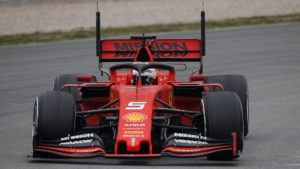
Drivers have done both long and short series as well as race simulations in order to obtain as much information as possible about their cars’ behaviour. Cars have also been able to use ‘pitot tube’ sensors and flow visualisation paint.

These devices allow for the speed of the air flow to be measured as it passes through the cars. Calibrating the aerodynamic efficiency has been another priority during this week’s sessions. Aside from assessing the strengths and weaknesses of the car, the testing sessions also serve to determine the optimal line of development that should be followed for the rest of the season.

Fighting against the clock, on the other hand, is not one of the tests priorities and so the time tables are not very significant. Each car is tested carrying different fuel loads, tire types, engine configurations and in specific asphalt conditions (temperatures).
Some teams, such as Mercedes, purposefully don’t aim to set the best times during testing so as to catch their opponents by surprise at the start of the season. Oo see the first the checkered flag at the 2019 Pre-season F1 testing is not a goal.

There is however some quantifiable data that tells us something about the cars. Ferrari and Mercedes have been the teams that have completed the most laps, 610 and 598 respectively. This is significant because despite the intensity of their training they have not suffered any setbacks for the four days.
The W10 of Lewis Hamilton and Valtteri Bottas and the SF90 of Sebastian Vettel and Charles Leclerc seem to be one hundred per cent reliable.
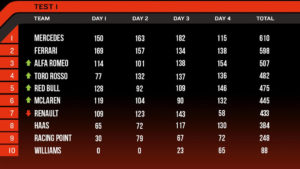
The most surprising fact at the 2019 Pre-season F1 testing, however, has nothing to do with the two favourite teams of the F1 but with the four Honda engines of Toro Rosso and Red Bull, which have happily lasted for the four days without breaking down.
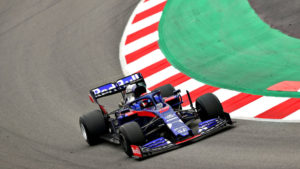
The constant issues with the Japanese engines that resulted in their parting with McLaren, seems to have been solved. The car from Faenza (STR14) has been fourth with 482 laps, eight more than its older brother, the RB15.

Alfa Romeo Racing (former Sauber) has also demonstrated the robustness of its engine by being the third Scuderia in number of laps. Kimi Raikkonen and Antonio Giovinazzi are delighted with their C38. 
McLaren has also stood out for the intensity of their testing. After five years of suffering all kinds of failures, they have finally managed to fulfil their set program. Although the MCL34 is not excessively stable and has considerable room for improvement, being able to carry out the work plan without major surprises is a big step forward.
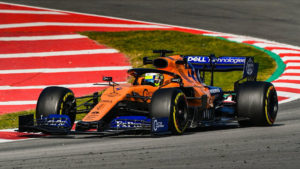
Carlos Sainz and Lando Norris have completed 445 laps with just some minor mishap at the 2019 Pre-season F1 testing. Some issues with the gearbox and the wiring. Despite these, they are miles away from their disastrous five-year period with Honda.
On the contrary, the performances of Haas, Racing Point and Williams have been disappointing. The VF19 of Romain Grosjean, Kevin Magnussen and his replacement, Pietro Fittipaldi has only managed 384 laps. Worse of all they have caused several red flags.

As far as the number of laps goes Racing Point is also one of the worse performing teams. Lance Stroll and Sergio Pérez have been unable to satisfy their work plan due to various faults with their car. They have only completed 248 laps at the 2019 Pre-season F1 testing.
Williams has not been able to start testing their FW42 until Wednesday, the day when this arrived from the factory. They have barely done 88 laps although, considering the delay, it is a miracle. The return of Robert Kubica to the F1 on Thursday. However, was one of the highlights for the British team. In any case, and considering Williams is the second most successful team in the history of the F1, these are really hard times for the team.

Finally, Renault has left a bittersweet taste in its fans’ mouths. Technical obstacles have prevented them from completing any more than 433 laps. In the last session on Thursday, however, the yellow cars of Nico Hulkenberg and Daniel Ricciardo set the first and third fastest time of the day.
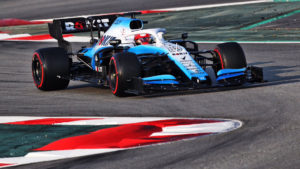
Nico Hulkenberg has topped the times table with a 1: 17.393 record at the 2019 Pre-season F1 testing. The German driver was wearing the softest compounds (C5) on his Renault RS19. Surprisingly, the Toro Rosso of Albon and Kvyat were the second and third fastest drivers respectively.
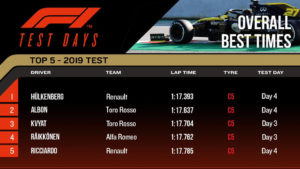
The Anglo-Thai sealed a spectacular 1: 17.637, only 67 thousandths better than his Russian teammate. Behind them came a rejuvenated Kimi Raikkonen, with a time of 1: 17.762. Finally, the other Renault of Daniel Ricciardo has closed the Top 5 with a 1: 17: 785.



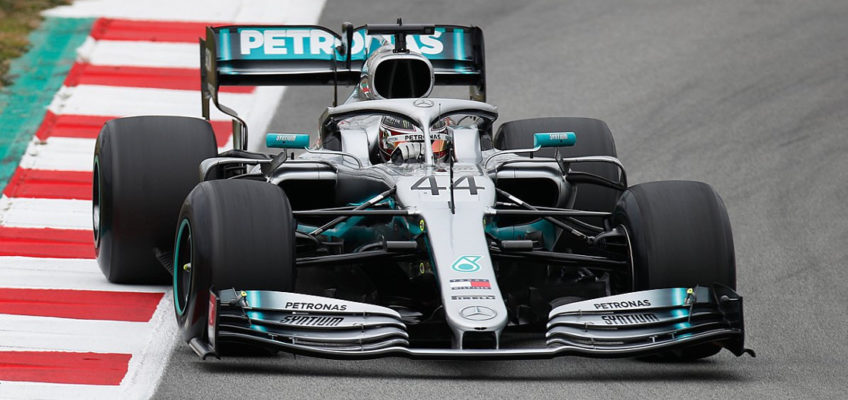

Leave a Reply